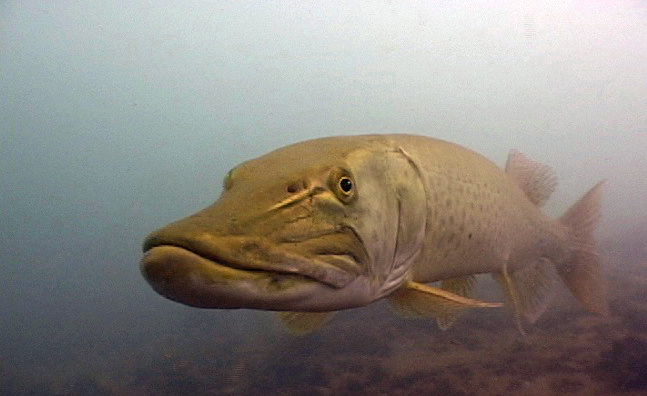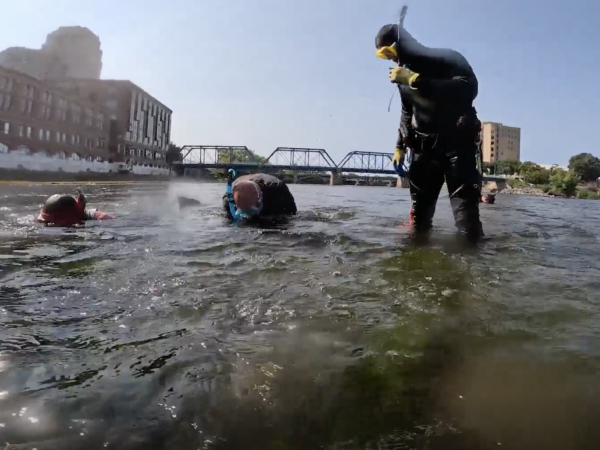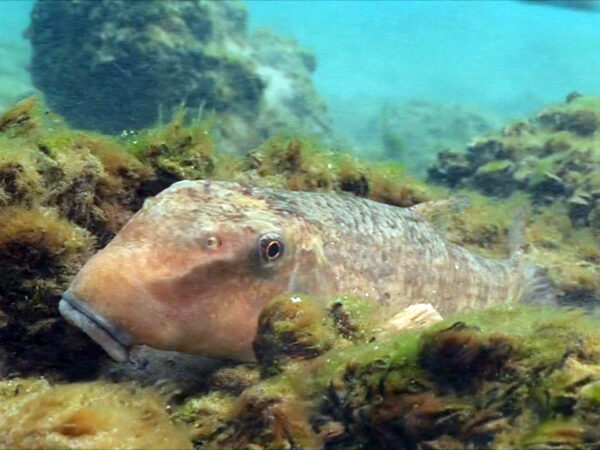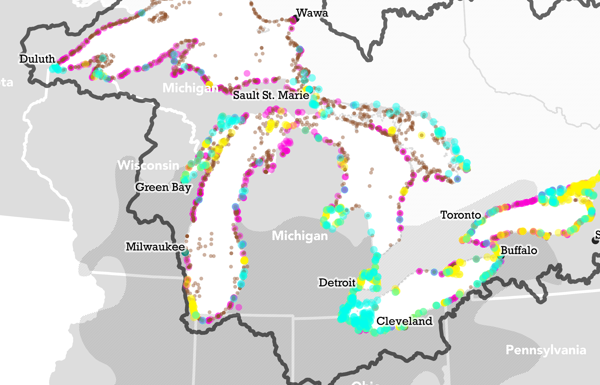
Just like serious birders and all manner of naturalists, many divers keep a life list of the species they have seen. Typically, the more elusive the species, the more coveted the sighting. Size also plays a role in desirability, whether it’s a condor or a blue whale.
When it comes to impressively large and elusive freshwater species, a couple come to mind.
But the one that took me a decade to check off my life list, the one I made hundreds of dives before seeing, the one that others on the same dive have spotted while I missed, would be the enigmatic muskellunge.
Fortunately, muskellunge – or muskies – are far more common today than when I began diving. Today, the majority of our dives in the St. Clair River now include a muskie sighting thanks to the world-class muskie fishery in Lake St. Clair.
Lake St. Clair has the ideal conditions for muskies with a maximum depth of 21 feet and an average depth of just 11 feet. In the summer, this shallow lake gets so warm that cold-water species like whitefish could never survive, but muskies can tolerate water temperatures from near-freezing all the way up to 90 degrees.
Lake St. Clair also contains the largest freshwater delta in the world. The St. Clair Delta is a thriving wetland ecosystem with acres of dense aquatic grasses that provide nursery habitat for fish, shelter for turtles and frogs, nesting sites for birds, and nirvana for a shallow-water predator like the muskie.
An average adult muskie is 3 feet long and about 40 pounds. A record-setting 58-inch muskie weighing roughly 65 pounds was caught in Georgian Bay at the top of Lake Huron in 1988. The world record stands at 72 inches and 70 pounds, according to both the Royal Ontario Museum’s Field Guide to Freshwater Fishes of Ontario as well as the U.S. Fish and Wildlife Service.
A muskie’s sleek torpedo-like form has natural camo-coloring with dark dots and squiggly markings over a beige or light olive body. They have an off-white belly and reddish fins rimmed with gold. In the mottled sunlight that streams into the shallow rice beds which are one of their preferred habitats, a muskie becomes nearly invisible.
Muskies are undeniably intimidating with a wide, gaping mouth overflowing with large razor-sharp teeth. They even have teeth on their tongues and the roofs of their mouths. As apex predators, adult muskies occupy the very top tier of the Great Lakes food chain.
They mostly hunt small- to mid-sized fish, but large muskies will not hesitate to take anything they can catch, from waterfowl and reptiles to semi-aquatic mammals like muskrats.
Muskies are considered ambush predators. They typically lie in wait near grass beds often in only a few feet of water. Like a cheetah stalking prey on the savanna, a muskie will patiently and motionlessly wait for a school of yellow perch to meander by or a mallard duckling to stray too far from its parents. Then with a stunning burst of speed, the muskie pounces.
When diving, I usually feel a muskie before I see it.
I’ll get that oddly disturbing sensation of being watched, an overwhelming and uncontrollable urge to check my hindquarter. When I get that feeling underwater, I know a muskie is probably nearby.
But you only see a muskie if the muskie lets you. And you’re paying attention.
Thankfully, muskies are fairly curious and somewhat territorial, so they occasionally grace divers with a cruise-by viewing. On two memorable dives, one stopped right beside me. I find it oddly appealing the way their noses are flattened kind of like a duck’s bill.
I’d love to spend a whole dive with a muskie, but sadly they seldom stick around for long. On rare instances one might shadow a diver for a hot minute, but more often than not muskies appear and disappear in about the same time it takes for a traffic light to switch from yellow to red.
Muskies can be equally elusive for fishermen as they are commonly known as the fish of a thousand casts.
Lake St. Clair has an active fleet of charter boats that service the muskie fishery. Unfortunately, not all fishermen are fans of the predator. Sportsmen targeting bass, perch, walleye or basically any other fish are typically not fans of muskies.
In some fishing circles, the belief is that muskies scare away other fish, or at least keep them from biting. But, even if they do, muskies are a native species hunting for survival. In my mind, that tops any kind of sport activity.
I can also empathize with the muskie as fishermen often accuse divers of similarly disrupting the fishing. Perhaps we do but, given the number of fish I’ve seen fishermen catch right after I have gotten out of the water after diving, I can guarantee any impact we make is strictly temporary.
In addition to there being far more muskies in the system now than 20 years ago, a reason I see more when diving now is because I’ve learned where to look. When the hair on the back of my neck stiffens, I immediately stare out into the edge of nothingness and wait.
Muskies like to hang right on the edge of the visibility.
Divers commonly refer to the distance from themselves to where everything fades into a dense grey fog as the viz or visibility. The viz at any given dive site can change in a matter of hours depending on any number of factors from wind and rain to boat wake.
Whether the edge of viz is 3 feet away or 20, if I keep watching and I’m lucky, a muskie will magically materialize out of the river fog. I can attest to the fact that the brief encounters are easy to miss.
Seeing a muskie is one thing. Filming a muskie is another matter entirely.
With an encounter time of less than 20 seconds, the camera not only needs to be setup and running, but a good autofocus is essential. Muskies are perfectly designed to blend in underwater. With their preference for hanging on the edge of nothingness, filming them is perversely challenging for both the camera and shooter.
I’m glad they are curious, else I’d never see them at all. It’s just a shame that they don’t find me nearly as interesting as I find them.
It makes no difference that I have already checked muskellunge off my life list. Every sighting is a thrill, and every dive that includes a muskie visit is a gift.
This column was inspired by reader suggestion. If there is a species, you’d like me to showcase please leave a comment below or email Great Lakes Now at nblakely@dptv.org.
Catch more news at Great Lakes Now:
I Speak for the Fish: Center stage alongside Great Lakes steelhead trout
Sturgeon Restoration: Drawing in the public with a festival
Featured image: The muskellunge, otherwise affectionately known as the muskie (Photo Credit: Greg Lashbrook/PolkaDot Perch)
23 Comments
-
World record muskie is not 72 inches and 70 pounds.
More like 65 pounds, 58 inches. A beast nonetheless.
Louis Spray’s claim is under contention
.-
Muskie records have an incredibly sordid history of being faked, time after time. Louis Spray’s (near) 70 pound claim from Wisconsin has long been disproved. His lie barely trumped what turned out to be another lie claimed from the St. Lawrence River, which barely beat another lie from Wisconsin… The 65 pound fish Tom spoke of, from Georgian Bay in 1988, has also been proven to be exaggerated. The actual largest musky ever known to be caught is 61 pounds, also from Georgian Bay in 2000.
-
@Duke thanks for commenting. An incredibly sordid history of fakes is the perfect way to describe muskie records! Feedback from you and the other readers has actually inspired a follow-up piece so thanks for taking the time to comment.
-
Doesn’t matter! Plain and simple, a monster fish, either way! Thanks for your interesting info! I’ve caught one and that was enough for me! 36″ on 6 lb. test w/ Mepps Comet and ultra-light rod and reel!
-
-
Wis record musky remains at 69 lbs has never been disputed except by critics who feel they must make themselves feel important
-
Unfortunately that’s not true Al. The Wisconsin musky is actually one of the more egregious lies of the many many record musky lies!! There is zero credibility, and zero chance that the Wisconsin 69#, or the Wisconsin 67#, or the other Wisconsin 60# ‘record’ fish were real. I wish they got that big, but they never did in inland Wisconsin. There’s an outside chance of a 60# Wisconsin musky, especially in Lake Michigan, but one has never ever been verified.
-
-
-
Many records from the 50s seem to be in question or taken off the books i believe
-
@Bruce, you are correct that some of the early records have been discredited. In our follow-up article we’ll be speaking with one of the Great Lakes leading ichthyologists to find out how and why some of the older records were debunked.
-
-
Hi, thanks for commenting. We appreciate the feedback and have decided to do a follow-up piece about the history of muskie fishing records in the Great Lakes! You can also see some muskie footage on our PolkaDot Perch YouTube channel @ https://youtu.be/khqWPwhWS_Q
-
-
The average muskie maybe in the 36″ to 42″ range, but the average weight is far less than the 40# quoted in the article. Probably true average is less than 20#, in Lake St. Clair 40#+ fish caught by anglers but they are still the exception, not the norm. Great article none the less, keep them coming!!
-
@SteveG thanks for taking the time to comment.
-
-
Thanks for your informative article. As a nature-loving biologist and snorkeler based in Ontario, I’ve encountered such piscine delights as northern pike, and a daddy bowfin escorting a brood of about 500 baby bowfins, but I’ve never (yet) seen a musky. It’s heartening to read that their numbers are up, even though the primary motive for their rising populations appears to be so that more humans can hook and catch them. My fishing career (1967-68) was short-lived once I realized I preferred looking at fishes in their element to seeing them on a hook, or a serving dish. Your readers might be interested in my 2016 book What A Fish Knows (a NYTimes bestseller now available in 16 languages).
-
@Jonathan sounds like we’re kindred spirits! A brood of 500 bowfin babies? Wow!! Just ordered a copy of your book. “Upends our assumptions about fishes, portraying them not as unfeeling, dead-eyed feeding machines but as sentient, aware, social, and even Machiavellian―in other words, much like us.” Can’t wait to read it! Thanks for sharing!!
-
-
Thank you for the informative piece on muskies. I’ve never encountered one under mask but I have spent time on Lake Superior shipwrecks where I was often amused by the abundance of (white) suckers and lawyers (burbot). One Michigan fish that I have only encountered once (in a net survey on the Huron River) is the Chain Pickerel, are they scarce or just elusive?
-
@John I’m not super familiar with the habits of chain pickerel, but I’ll be speaking with a couple of Great Lakes fisheries experts in the next week and plan to ask them your question. I’ll post their replies here!
-
@John, I’ve spoken with several experts and while they have heard of chain pickerel, none have seen one alive. So, I think it’s safe to say they are scarce!
-
-
-
My father fished with Louie and there is no disputing the fish, there is a dispute on the scale that weighed it. The Chippewa Flowage and Eau Claire lakes area were Louie’s primary fishing area. There have been larger fish shocked in several lakes near where our cabin is in the Gordon, Wisconsin area. No official weighing of those fish but based on girth/length weight was believed to be larger than any ever caught with a rod and reel.
-
@Forrest thanks for sharing!
-
-
36” muskie weights 40lbs. How in the world did you get those numbers? I fish there everyday and the biggest I have caught is 56 1/4″ and it weight 42 lbs so…………..
-
@Brandon, sources for this piece include the ROM Field Guide to Freshwater Fishes of Ontario, Michigan DNR website and the US Fish and Wildlife Service website. But watch for a follow-up piece inspired by reader feedback like yours! Thanks for commenting!
-
-
I spent many, many hours fishing for muskies although I hooked was never successful in landing them but I was fun trying
-
@Robert thanks for taking the time to comment! You can see some muskie footage, and other Great Lakes species, on the PolkaDot Perch YouTube channel @ https://youtu.be/khqWPwhWS_Q
-
-
While I don’t want to jump on the bandwagon of correcting a nicely written piece, I will just say that recent studies are showing that Muskies can perish from warm water temps as low as 78 degrees, so the claim that they can “tolerate 90 degree water” is in most situations not true.




